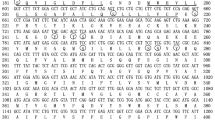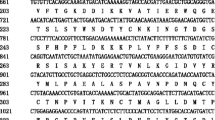Abstract
Background
Acetyl-CoA carboxylase (ACC) catalyzes the carboxylation of acetyl-CoA to malonyl-CoA. Malonyl-CoA, which plays a key role in regulating glucose and lipid metabolism, is not only a substrate for fatty acid synthesis but also an inhibitor of the oxidation pathway. ACC exists as two isoenzymes that are encoded by two different genes. ACC1 in grass carp (Ctenopharyngodon idellus) has been cloned and sequenced. However, studies on the cloning, tissue distribution, and function of ACC2 in grass carp were still rare.
Methods and results
The full-length cDNA of acc2 was 8537 bp with a 7146 bp open reading frame encoding 2381 amino acids. ACC2 had a calculated molecular weight of 268.209 kDa and an isoelectric point of 5.85. ACC2 of the grass carp shared the closest relationship with that of the common carp (Sinocyclocheilus grahami). The expressions of acc1 and acc2 mRNA were detected in all examined tissues. The expression level of acc1 was high in the brain and fat but absent in the midgut and hindgut. The expression level of acc2 in the kidney was significantly higher than in other tissues, followed by the heart, brain, muscle, and spleen. ACCs inhibitor significantly reduced the levels of glucose, malonyl-CoA, and triglyceride in hepatocytes.
Conclusions
This study showed that the function of ACC2 was evolutionarily conserved from fish to mammals. ACCs inhibitor inhibited the biological activity of ACCs, and reduced fat accumulation in grass carp.





Similar content being viewed by others
Data availability
All data are available from the corresponding author by request.
References
FBMA, F.Bo.MoAo.C (2023) China fishery statistical yearbook. China Agriculture Press, Beijing
Wu BL, Huang L, Chen J, Zhang Y, Chen XJ, Wu CC, Deng XJ, Gao J, He JX (2021) Effects of feeding frequency on growth performance, feed intake, metabolism and expression of fgf21 in grass carp (Ctenopharyngodon Idellus). Aquaculture 545(15):737196. https://doi.org/10.1016/j.aquaculture.2021.737196
Xie NN, Wen H, Xie SQ, Jiang M, Yu LJ, Wu F, Lu X, Meng XL, Tian J (2021) Adaptations of hepatic lipid and glucose metabolism in response to high-macronutrient diets in juvenile grass carp. Aquac Nutr 27(5):1738–1749. https://doi.org/10.1111/anu.13311
Du ZY, Clouet P, Huang LM, Degrace P, Zheng WH, He JG, Tian LX, Liu YJ (2008) Utilization of different dietary lipid sources at high level in herbivorous grass carp (Ctenopharyngodon idella): mechanism related to hepatic fatty acid oxidation. Aquac Nutr 14(1):77–92. https://doi.org/10.1111/j.1365-2095.2007.00507.x
Guo XZ, Liang XF, Fang L, Yuan XC, Zhou Y, Zhang J, Li B (2013) Effects of dietary non-protein energy source levels on growth performance, body composition and lipid metabolism in herbivorous grass carp (Ctenopharyngodon idella Val). Aquac Res 46(5):1197–1208. https://doi.org/10.1111/are.12275
Shi XC, Sun J, Yang Z, Li XX, Ji H, Li Y, Chang ZG, Du ZY, Chen LQ (2017) Molecular characterization and nutritional regulation of carnitine palmitoyltransferase (CPT) family in grass carp (Ctenopharyngodon Idellus). Comp Biochem Physiol B Biochem Mol Biol 203:11–19. https://doi.org/10.1016/j.cbpb.2016.08.006
Yuan X, Zhou Y, Liang XF, Li J, Liu L, Li B, He Y, Guo X, Fang L (2013) Molecular cloning, expression and activity of pyruvate kinase in grass carp Ctenopharyngodon idella: effects of dietary carbohydrate level. Aquaculture 410:32–40. https://doi.org/10.1016/j.aquaculture.2013.06.009
Barber MC, Price NT, Travers MT (2005) Structure and regulation of acetyl-CoA carboxylase genes of metazoa. Biochim Biophys Acta 1733(1):1–28. https://doi.org/10.1016/j.bbalip.2004.12.001
Tong L (2005) Acetyl-coenzyme A carboxylase: crucial metabolic enzyme and attractive target for drug discovery. Cell Mol Life Sci 62(16):1784–1803. https://doi.org/10.1007/s00018-005-5121-4
Kim KH (2003) Regulation of mammalian acetyl-coenzyme A carboxylase. Annu Rev Nutr 17(1):77–99. https://doi.org/10.1146/annurev.nutr.17.1.77
Munday MR (2002) Regulation of mammalian acetyl-CoA carboxylase. Biochem Soc Trans 30(6):1059–1064. https://doi.org/10.1042/bst0301059
Rasmussen BB, Holmbäck UC, Volpi E, Morio-Liondore B, Paddon-Jones D, Wolfe RR (2002) Malonyl coenzyme A and the regulation of functional carnitine palmitoyltransferase-1 activity and fat oxidation in human skeletal muscle. J Clin Invest 110(11):1687–1687. https://doi.org/10.1172/JCI15715
Cheng HL, Ji NJ, Peng YX, Shen X, Xu JH, Dong ZG, Wu CC (2011) Molecular characterization and tissue-specific expression of the acetyl-CoA carboxylase α gene from Grass carp, Ctenopharyngodon idella. Gene 487(1):46–51. https://doi.org/10.1016/j.gene.2011.07.027
Wang K (2012) Changes in main biochemical indices and acetyl-CoA carboxylase 1 mRNA expression of crass carp fed a high-fat diet. Chin J Animal Nutr 24:2375–2383
Zhou J, Han D, Jin J, Xie S, Yang Y, Zhu X (2014) Compared to fish oil alone, a corn and fish oil mixture decreases the lipid requirement of a freshwater fish species, Carassius auratus Gibelio. Aquaculture 428:272–279. https://doi.org/10.1016/j.aquaculture.2014.03.029
Kuwashiro S, Terai S, Oishi T, Fujisawa K, Matsumoto T, Nishina H, Sakaida I (2011) Telmisartan improves nonalcoholic steatohepatitis in medaka (Oryzias latipes) by reducing macrophage infiltration and fat accumulation. Cell Tissue Res 344(1):125–134. https://doi.org/10.1007/s00441-011-1132-7
Zheng JL, Luo Z, Zhu QL, Tan XY, Chen QL, Sun LD, Hu W (2013) Molecular cloning and expression pattern of 11 genes involved in lipid metabolism in yellow catfish Pelteobagrus fulvidraco. Gene 531(1):53–63. https://doi.org/10.1016/j.gene.2013.08.028
Gapp B, Jourdain M, Bringer P, Kueng B, Weber D, Osmont A, Zurbruegg S, Knehr J, Falchetto R, Roma G, Dietrich W, Valdez R, Beckmann N, Nigsch F, Sanyal AJ, Ksiazek I (2020) Farnesoid X receptor agonism, acetyl-coenzyme A carboxylase inhibition, and back translation of clinically observed endpoints of De Novo Lipogenesis in a Murine NASH Model. Hepatol Commun 4(1):109–125. https://doi.org/10.1002/hep4.1443
Matsumoto M, Yashiro H, Ogino H, Aoyama K, Nambu T, Nakamura S, Nishida M, Wang X, Erion DM, Kaneko M (2020) Acetyl-CoA carboxylase 1 and 2 inhibition ameliorates steatosis and hepatic fibrosis in a MC4R knockout murine model of nonalcoholic steatohepatitis. PLoS ONE 15(1):e0228212. https://doi.org/10.1371/journal.pone.0228212
Harriman G, Greenwood J, Bhat S, Huang X, Wang R, Paul D, Tong L, Saha AK, Westlin WF, Kapeller R, Harwood HJ Jr (2016) Acetyl-CoA carboxylase inhibition by ND-630 reduces hepatic steatosis, improves insulin sensitivity, and modulates dyslipidemia in rats. Proc Natl Acad Sci USA 113(13):E1796–E1805. https://doi.org/10.1073/pnas.1520686113
Harwood HJ Jr, Petras SF, Shelly LD, Zaccaro LM, Perry DA, Makowski MR, Hargrove DM, Martin KA, Tracey WR, Chapman JG, Magee WP, Dalvie DK, Soliman VF, Martin WH, Mularski CJ, Eisenbeis SA (2003) Isozyme-nonselective N-substituted bipiperidylcarboxamide acetyl-CoA carboxylase inhibitors reduce tissue Malonyl-CoA concentrations, inhibit fatty acid synthesis, and increase fatty acid oxidation in cultured cells and in experimental animals. J Biol Chem 278(39):37099–37111. https://doi.org/10.1074/jbc.M304481200
Jiang YH, Mao Y, Lv YN, Tang LL, Zhou Y, Zhong H, Xiao J, Yan JP (2018) Natural Resistance Associated Macrophage Protein Is Involved in Immune Response of Blunt Snout Bream, Megalobrama amblycephala. Cells 7(4):27. https://doi.org/10.3390/cells7040027
Kumar S, Stecher G, Tamura K (2016) MEGA7: molecular evolutionary genetics analysis version 7.0 for bigger datasets. Mol Biol Evol 33(7):1870–1874. https://doi.org/10.1093/molbev/msw054
Abu-Elheiga L, Almarza-Ortega DB, Baldini A, Wakil SJ (1997) Human acetyl-CoA carboxylase 2: molecular cloning, characterization, chromosomal mapping, and evidence for two isoforms. J Biol Chem 272:10669–10677. https://doi.org/10.1074/jbc.272.16.10669
Abu-Elheiga L, Brinkley WR, Zhong L, Chirala SS, Woldegiorgis G, Wakil SJ (2000) The subcellular localization of acetyl-CoA carboxylase 2. Proc Natl Acad Sci USA 97:1444–1449. https://doi.org/10.1073/pnas.97.4.1444
Abu-Elheiga L, Matzuk MM, Abo-Hashema KA, Wakil SJ (2001) Continuous fatty acid oxidation and reduced fat storage in mice lacking acetyl-CoA carboxylase 2. Science 291(5513):2613–2616. https://doi.org/10.1126/science.1056843
Rollin X, Médale F, Gutieres S, Blanc D, Kaushik SJ (2003) Short- and long-term nutritional modulation of acetyl-CoA carboxylase activity in selected tissues of rainbow trout (Oncorhynchus mykiss). Br J Nutr 89(6):803–810. https://doi.org/10.1079/BJN2003844
Zhang XQ, Xu JH, Pan Q, Yi LF, Peng YX, Shen X, Yan BL, Gao H, Wang WX, Cheng HL (2016) Full length cDNA molecular cloning of acetyl-CoA carboxylase αgene and effects of dietary lipid level on its expression in the liver of half-smooth Tongue Sole (Cynoglossus semilaevis). Chin J Anim Nutr 28(2):485–497
Garbay B, Bauxis-Lagrave S, Boiron-Sargueil F, Elson G, Cassagne C (1997) Acetyl-CoA carboxylase gene expression in the developing mouse brain. Comparison with other genes involved in lipid biosynthesis. Brain Res Dev Brain Res 98(2):197–203. https://doi.org/10.1016/s0165-3806(96)00169-1
Kreuz S, Schoelch C, Thomas L, Rist W, Rippmann JF, Neubauer H (2009) Acetyl-CoA carboxylases 1 and 2 show distinct expression patterns in rats and humans and alterations in obesity and diabetes. Diabetes Metab Res Rev 25(6):577–586. https://doi.org/10.1002/dmrr.997
Iverson AJ, Bianchi A, Nordlund AC, Witters LA (1990) Immunological analysis of acetyl-CoA carboxylase mass, tissue distribution and subunit composition. Biochem J 269(2):365–371. https://doi.org/10.1042/bj2690365
Vernon RG, Barber MC, Travers MT (1999) Present and future studies on lipogenesis in animals and human subjects. Proc Nutr Soc 58(3):541–549. https://doi.org/10.1017/s0029665199000713
Newsholme EA, Start C (1973) Regulation of carbohydrate metabolism in liver and regulation of fat metabolism in liver. Regulation in metabolism. Wiley, New York, pp 247–316
Hillgartner FB, Charron T, Chesnut KA (1996) Alterations in nutritional status regulate acetyl-CoA carboxylase expression in avian liver by a transcriptional mechanism. Biochem J 319:263–268. https://doi.org/10.1042/bj3190263
Kim CW, Addy C, Kusunoki J, Anderson NN, Deja S, Fu X, Burgess SC, Li C, Ruddy M, Chakravarthy M, Previs S, Milstein S, Fitzgerald K, Kelley DE, Horton JD (2017) Acetyl CoA carboxylase inhibition reduces hepatic steatosis but elevates plasma triglycerides in mice and humans: a bedside to bench investigation. Cell Metab 26(2):394–406. https://doi.org/10.1016/j.cmet.2017.07.009
Sone H, Kamiyama S, Higuchi M, Fujino K, Kubo S, Miyazawa M, Shirato S, Hiroi Y, Shiozawa K (2016) Biotin augments acetyl CoA carboxylase 2 gene expression in the hypothalamus, leading to the suppression of food intake in mice. Biochem Biophys Res Commun 476(3):134–139. https://doi.org/10.1016/j.bbrc.2016.04.152
Wu X, Huang T (2020) Recent development in acetyl-CoA carboxylase inhibitors and their potential as novel drugs. Future Med Chem 12(6):533–561. https://doi.org/10.4155/fmc-2019-0312
Olson DP, Pulinilkunnil T, Cline GW, Shulman GI, Lowell BB (2010) Gene knockout of Acc2 has little effect on body weight, fat mass, or food intake. Proc Natl Acad Sci USA 107(16):7598–7603. https://doi.org/10.1073/pnas.0913492107
Funding
This study was supported by the National Natural Science Foundation of China (No.31702361).
Author information
Authors and Affiliations
Contributions
Juan Tian and Feng Huang designed the research; Manxia Cao, Xinyuan Li, Jianmin Zhang, Lixue Dong, Ming Jiang, Hua Wen, and Xing Lu conducted the experiments and analyzed the data; Manxia Cao, Xinyuan Li, and Juan Tian wrote the paper.
Corresponding authors
Ethics declarations
Competing interests
The authors declare no competing interests.
Ethics approval
Grass carp (Ctenopharyngodon idella) is widely cultivated in China and are not listed as endangered or protected species. All animal care and use procedures were approved by the Institutional Animal Care and Use Committee of Yangtze River Fisheries Research Institute (according to YFI 2018-40 of July 20, 2018). Grass carp were anesthetized with MS-222 in 80 mg L−1 water to minimum suffering before being assigned to tanks and were anesthetized death with MS-222 in 80 mg L−1 water when sampling muscle and hepatopancreas in this experiment.
Consent to participate
Informed consent was obtained from all study subjects before participating in the study.
Consent for publication
All authors have contributed significantly and agree with the publication content of the paper.
Additional information
Publisher’s Note
Springer nature remains neutral with regard to jurisdictional claims in published maps and institutional affiliations.
Rights and permissions
Springer Nature or its licensor (e.g. a society or other partner) holds exclusive rights to this article under a publishing agreement with the author(s) or other rightsholder(s); author self-archiving of the accepted manuscript version of this article is solely governed by the terms of such publishing agreement and applicable law.
About this article
Cite this article
Cao, M., Li, X., Dong, L. et al. Molecular cloning and gene expression of acc2 from grass carp (Ctenopharyngodon idella) and the regulation of glucose metabolism by ACCs inhibitor. Mol Biol Rep 51, 402 (2024). https://doi.org/10.1007/s11033-024-09286-y
Received:
Accepted:
Published:
DOI: https://doi.org/10.1007/s11033-024-09286-y




